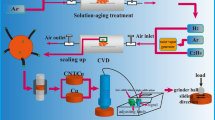Abstract
Electroless Cu plating was used for flake G powder and CNTs, Cu–G–CNTs (copper/graphite/carbon nanotubes) composites were manufactured by means of powder metallurgical method. The influences of CNTs on the mechanical properties, conductivity properties, friction, and wear performance of the composite were examined. The results indicate that adding a small amount of CNTs can improve comprehensive property of the composites, especially mechanical property. However, excessive CNT, which is easily winding reunion and grain boundary segregation, results in performances degradation.









Similar content being viewed by others
References
Han YY, Guo H, Yin FZ, Zhang XM, Chu K, Fan YM. Microstructure and thermal conductivity of copper matrix composites reinforced with mixtures of diamond and SiC particles. Rare Met. 2012;31(1):58.
Esawi AMK, Morsi K, Gawad A, Borah P. Fabrication and properties of dispersed carbon nanotube-aluminum composites. Mater Sci Eng, A. 2009;508(3):167.
Chen PW, Chung DL. Carbon fiber reinforced concrete as an electrical contact material for smart structures. Smart Mater Struct. 1993;38(2):181.
Ding HD, Li YW, Hao HQ. The relationship between the bending strength and the gap of copper-graphite material. T Nonferr Metal Soc. 1996;4(6):123.
Rajkumar K, Aravindan S, Kulkarni MS. Wear and life characteristics of microwave-sintered copper-graphite composite. J Mater Eng Perform. 2012;21(11):2389.
Kohno M, Orii T, Hirasawa M. Growth of single-walled carbon nanotubes from size-selected catalytic metal particles. Appl Phys Lett. 2004;79(5):787.
Shaikh S, Lafdi K, Silverman E. The effect of a CNT interface on the thermal resistance of contacting surfaces. Carbon. 2007;45(4):695.
Wang F, Arai S, Endo M. Metallization of multi-walled carbon nanotubes with copper by an electroless deposition process. Electrochem Commun. 2004;6(10):1042.
Dovoush WM. Processing and characterization of CNT/Cu nanocomposites by powder technology. Powder Metall Met C+. 2008;47(9):531.
Nie JH, Jia CC, Jia X, Zhang YF, Shi N, Li Y. Fabrication, microstructures, and properties of copper matrix composites reinforced by molybdenum-coated carbon nanotubes. Rare Met. 2011;30(4):401.
Deng M, Ding GF, Wang Y. MEMS-based carbon nanotube and carbon nanofiber Cu micro special electric contact. J Micromech Microeng. 2009;19(6):21.
Yang C, Hazeghi A, Takei K. Low-resistance electrical contact to carbon nanotubes with graphitic interfacial layer. IEEE T Electron Dev. 2012;59(1):12.
Nie JS, Jia X, Jia CC, Li Y, Zhang YF, Shi N. Friction and wear properties of copper matrix composites reinforced by tungsten-coated carbon nanotubes. Rare Met. 2011;30(6):657.
Feng Y, Zhang M, Xu Y. Effect of the electric current on the friction and wear properties of the CNT-Ag-G composites. Carbon. 2005;43(13):2685.
Wang J, Feng Y, Li S, Lin S. Influence of graphite content on sliding wear characteristics of MWCNTs–Ag–G electrical contact materials. T Nonferr Metal Soc. 2009;19(1):113.
Hu ZL, Chen ZH, Xia JT. Study on surface film in the electrographite brushes against copper commutators for variable current and humidity. Wear. 2008;264(2):11.
Zhang GY, Zhang H, Wei D. Carbon nanotubes enhance aluminum composite material electronic theory research. Acta Phys Sinica Chin Ed. 2007;56(3):1581.
Emge A, Karthikeyan S, Kim HJ, Rigney DA. The effect of sliding velocity on the tribological behavior of copper. Wear. 2007;266(3):614.
Zhao NQ, Li JJ, Yang XJ. Influence of the P/M process on the microstructure and properties of WC reinforced copper matrix composite. J Mater Sci. 2004;39(15):4829.
Acknowledgments
This project was financially supported by the National Nature Science Foundation of China (No. 51003060), the Distinguished Young Talents in Higher Education of Guangdong China (No. 2012LYM_0118), and the Shenzhen Innovation and Technology Commission under the Strategic Emerging Industries Development Project (No. ZDSY20120612094418467).
Author information
Authors and Affiliations
Corresponding author
Rights and permissions
About this article
Cite this article
Liu, XY., Xiang, XZ., Niu, F. et al. Properties of copper/graphite/carbon nanotubes composite reinforced by carbon nanotubes. Rare Met. 32, 278–283 (2013). https://doi.org/10.1007/s12598-013-0079-0
Received:
Revised:
Accepted:
Published:
Issue Date:
DOI: https://doi.org/10.1007/s12598-013-0079-0




